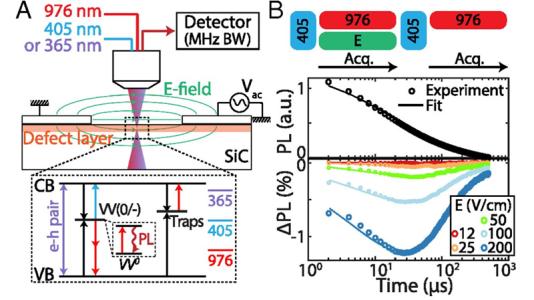
Scientific Achievement
Using the optical properties and charge state dynamics of point defects in silicon carbide (SiC) to sense high frequency (MHz-GHz) electric field fluctuations.
Significance and Impact
Provides a means for all-optical, high frequency electrometry with quantum defects with a measured electric field sensitivity of 41 (?/???)/√Hz.
Research Details
- A simple to implement, all-optical electrometry technique based on changes in the photoluminescence due to optical charge conversion of point defects in silicon carbide using both a UV and near-IR excitation wavelengths.
- Under near-IR excitation, the defect photoluminescence becomes darker and as an electric field is applied, this change in photoluminescence (time decay) becomes faster.
- Technique is highly sensitive to electric fields and sensitive to high frequency (MHz-GHz) electric and strain fields, making it ideal for studying MEMs structures.
Argonne National Laboratory seeks solutions to pressing national problems in science and technology. The nation’s first national laboratory, Argonne conducts leading-edge basic and applied scientific research in virtually every scientific discipline. Argonne researchers work closely with researchers from hundreds of companies, universities, and federal, state and municipal agencies to help them solve their specific problems, advance America’s scientific leadership and prepare the nation for a better future. With employees from more than 60 nations, Argonne is managed by UChicago Argonne, LLC for the U.S. Department of Energy’s Office of Science.
The U.S. Department of Energy’s Office of Science is the single largest supporter of basic research in the physical sciences in the United States and is working to address some of the most pressing challenges of our time. For more information, visit https://energy.gov/science.